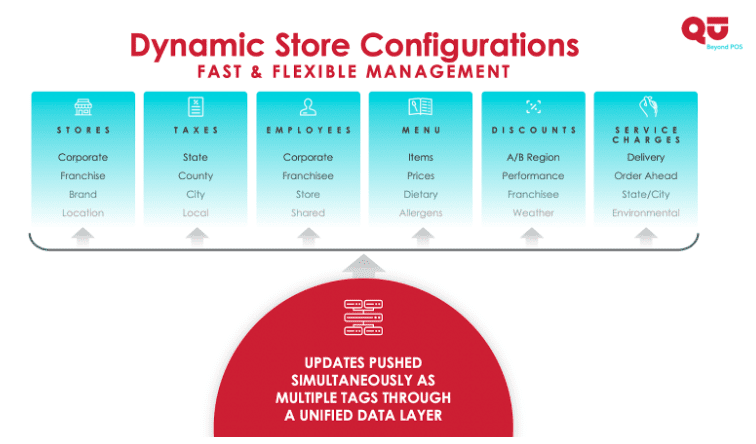All POS users have long suffered the pain of rigid, complex, and time-consuming store configurations. Up until now, legacy POS software limited store and menu configurations to a single hierarchical structure focused around a geographical location with rigid rules.
But with the explosion of digital channels, enterprise operators desperately sought more flexibility to create and configure store categories in a way that fits their omni-channel business requirements.
The dire need to provide enterprise chains with more control to customize their stores, channels, and menus one time—and in one place—led Qu technologists to create Dynamic Store capabilities.
Qu’s Dynamic Stores is a ground-breaking feature that simplifies enterprise restaurant management through expanded categories and grouping options, limitless attributes, and powerful data tagging and inheritance. These features all combine to drive you closer to the promised land of single source of truth data and one view of the guest.
Dynamic Stores Offer Infinite Possibilities & Combinations
Qu’s dynamic stores capability provides enterprise operators with the flexibility, scalability, and repeatability needed to make new store configurations and menu changes across channels, faster—removing common obstacles created by legacy POS tools born in the pre-digital era. The single menu management capability further simplifies the process.
Enterprise restaurant operators can now configure stores and channels with these broader capabilities and more granular controls:
- Create multiple types of groups and hierarchies, enabling you to manage brands and stores—individually or at the group level—with flexible permissions. There are no limits to the number of groups a store can belong to.
- Make changes one time, within and across groups. Changes can be shared across groups through our data tagging and inheritance model. Once you add a store to a group, it automatically inherits that group’s attributes, so there’s no extra configurations or tweaking required.
- Configure groups based on more relevant business criteria within these six main categories:
- Menus—Dynamic items, prices, dietary needs, allergens
- Taxes—Rates, Flat Tax, Order Channel, Order Type
- Employees— Payroll Profile, Job Title, Permissions
- Service charges— Rate, Order Channel, Order Type
- Discounts— Coupons, Applied to Items, BOGOs, Automatic
- Store locations— Hardware configurations, Printer settings, Payments, Corporate reporting requirements, and other unique company needs
The bottom line: large, multi-brand chains can now make global changes anytime, anywhere through one centralized location—saving countless hours, errors and dollars.
Franchisee Freedom with Enterprise Consistency
Large, multi-location brands with franchises have struggled to manage stores efficiently and view the restaurant data needed to accurately assess performance. Legacy and first-gen cloud POS systems have been too rigid to match real-world operations. By limiting store configuration capabilities and reporting to static templates and hierarchies based on geography alone, legacy POS created more problems than anticipated.
The result: Customers aren’t enjoying the level of unified food experiences that increase brand loyalty.
Restaurant stores have many common characteristics (and differences) apart from their zip codes. Some are owned by the same franchisee. Some share menus but have their own complex tax structures. Others offer the same promotions with different prices. The list goes on.
Qu’s Dynamic Stores functionality makes management much easier for franchises. Fast-growing restaurant operators have the freedom to configure stores and store reporting, collect data-driven insights within and across brands, and efficiently manage changes in co-located brands from one central location.
For example, as a franchisor, you may want to limit access to menu changes while simultaneously giving franchisees the ability to manage their taxes and service charges. Not a problem with dynamic stores! Similarly, if you want franchisees to manage menus but limit access to discount changes, dynamic stores make that possible as well.
With Qu, your business goals, not your POS software, dictate decisions about your store hierarchies. Want to add stores to participate in a promotion for certain dates and times? Just drop them in the group. Finally … you can manage your business in a way that makes the most sense for your brand.
Having this granular level of control and flexible data governance is essential for operators seeking to improve bottom-line performance across multiple locations.

Qu’s dynamic multi-store modeling offers flexible data hierarchies and groupings.
Unlock the Unlimited Power of Dynamic Stores
Qu developed dynamic stores to give operators scalability, flexibility, more local control and a robust view of stores based on factors beyond location. In addition, operators will enjoy these key benefits to enable their future growth and profitability:
- Speed – faster configurations and menu/store management. Reduce inconsistencies and rework with tagging and inheritance across groups.
- Flexibility – more customized structures to work within to improve omni-channel management. Create customized groups, with 100s of attributes and flexible permissions.
- Control – better control of brand experiences with more consistent, single-source menu, item, and store data exposed across all your on and off-line order channels.
- Scalability – more confidently plan and manage your restaurant’s growth with modern, agile architecture at the foundation of your business.
- Unified – a single repository for all your data stores; and one central management hub to make changes means one view of the customer and one centralized reporting source.
Qu’s dynamic stores provide the POS capabilities you need to get a unified look at, and better control over, all your locations.
Experience the newest revolution in restaurant POS systems now. Find Out if Dynamic Stores are Right for Your Business.


